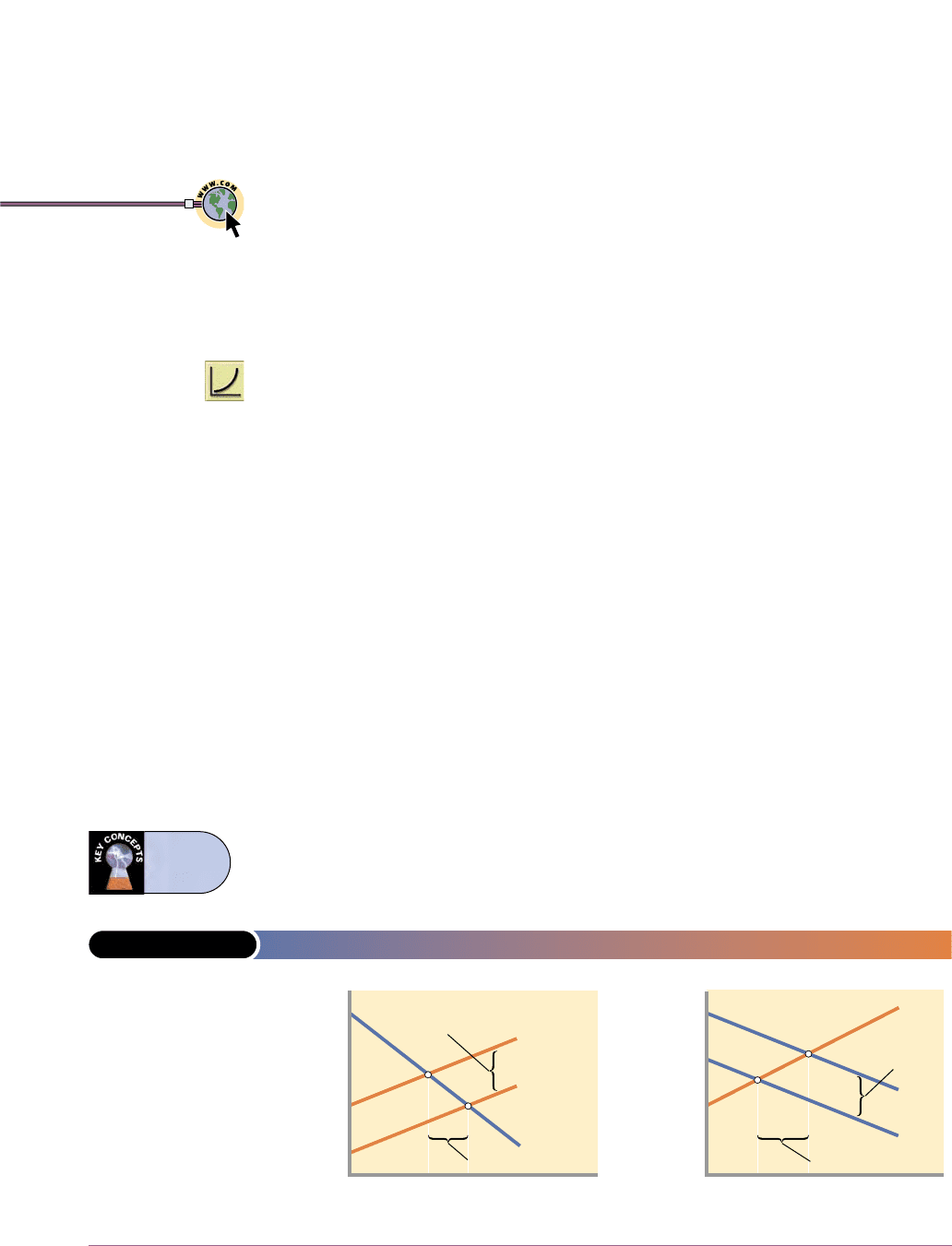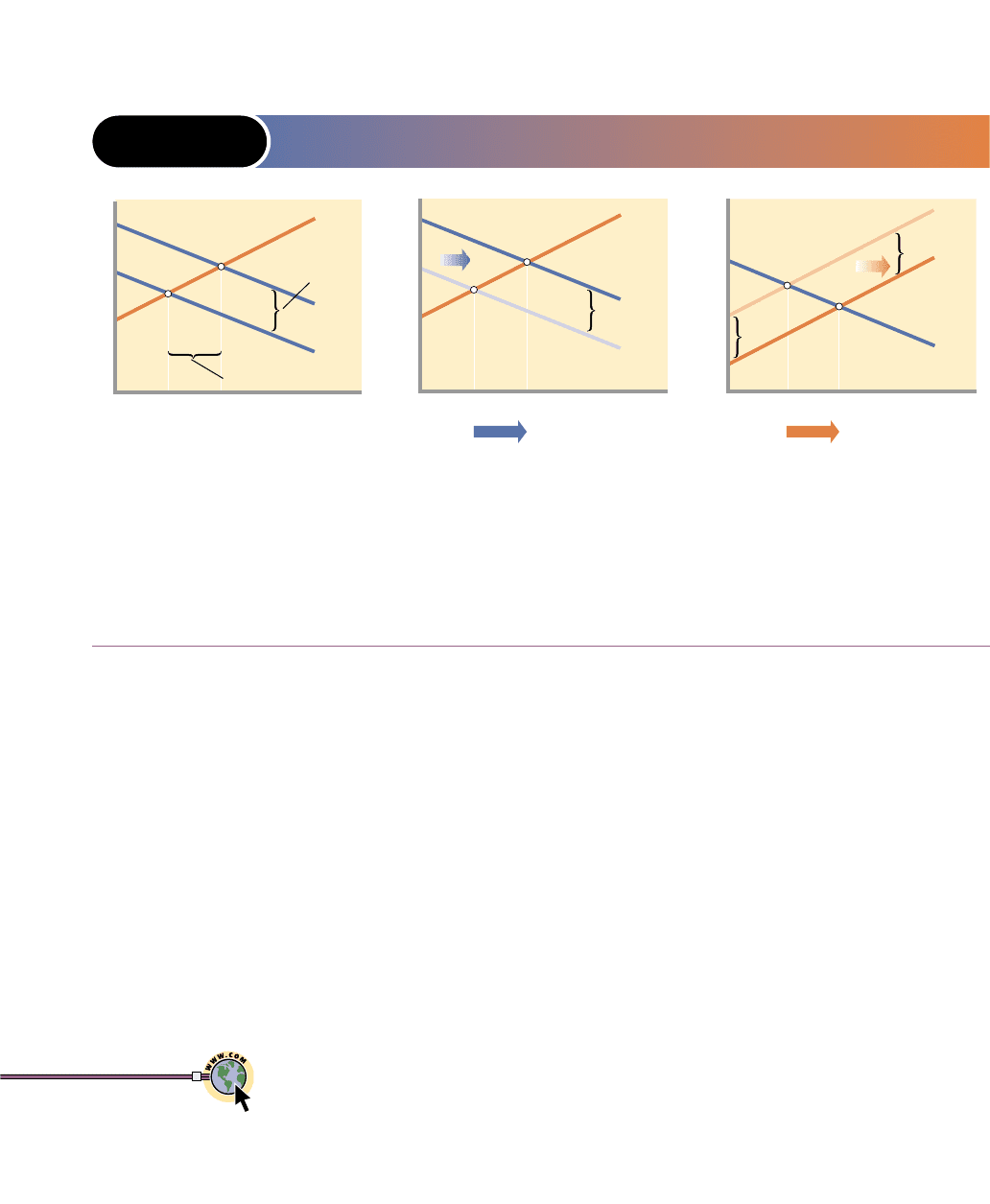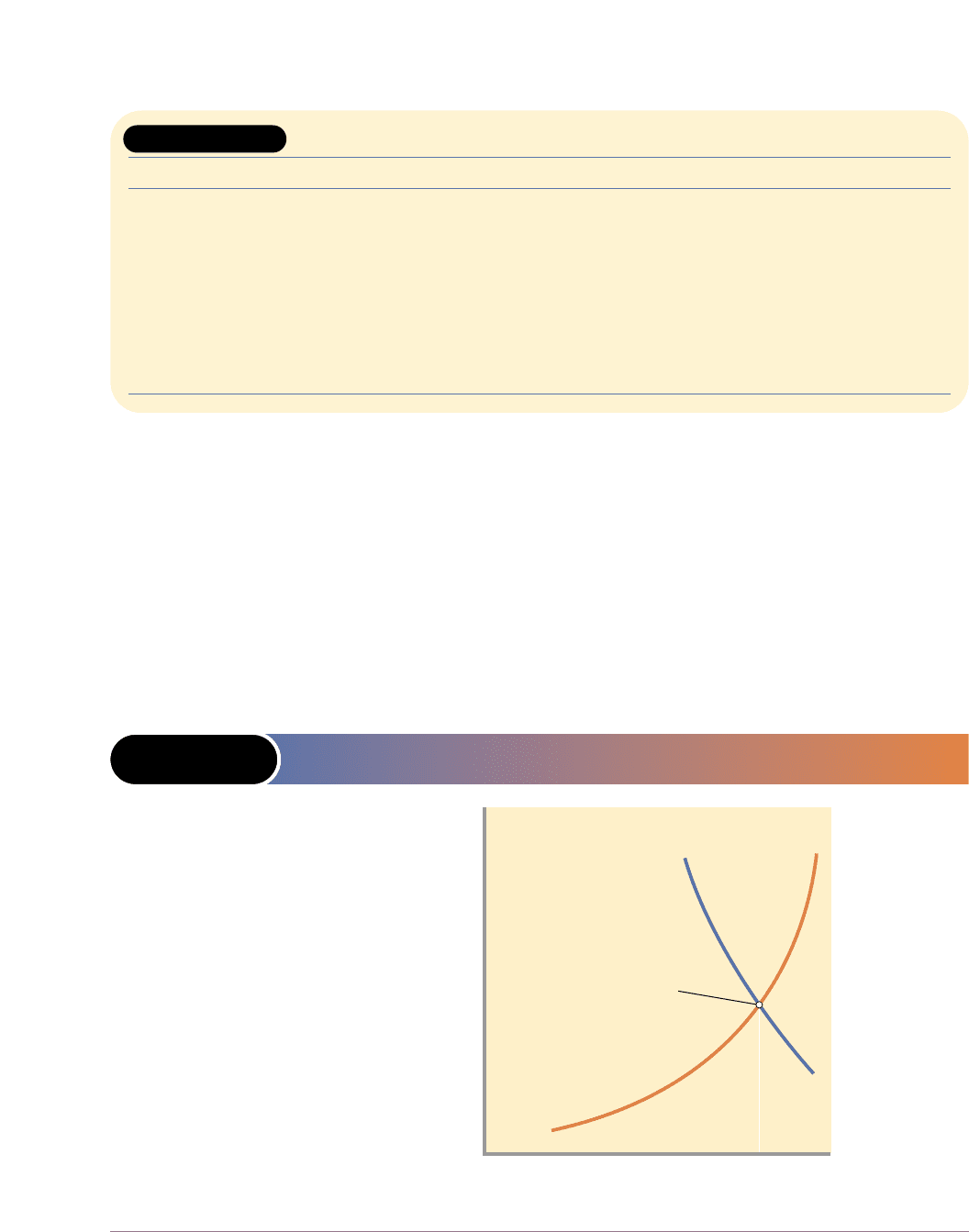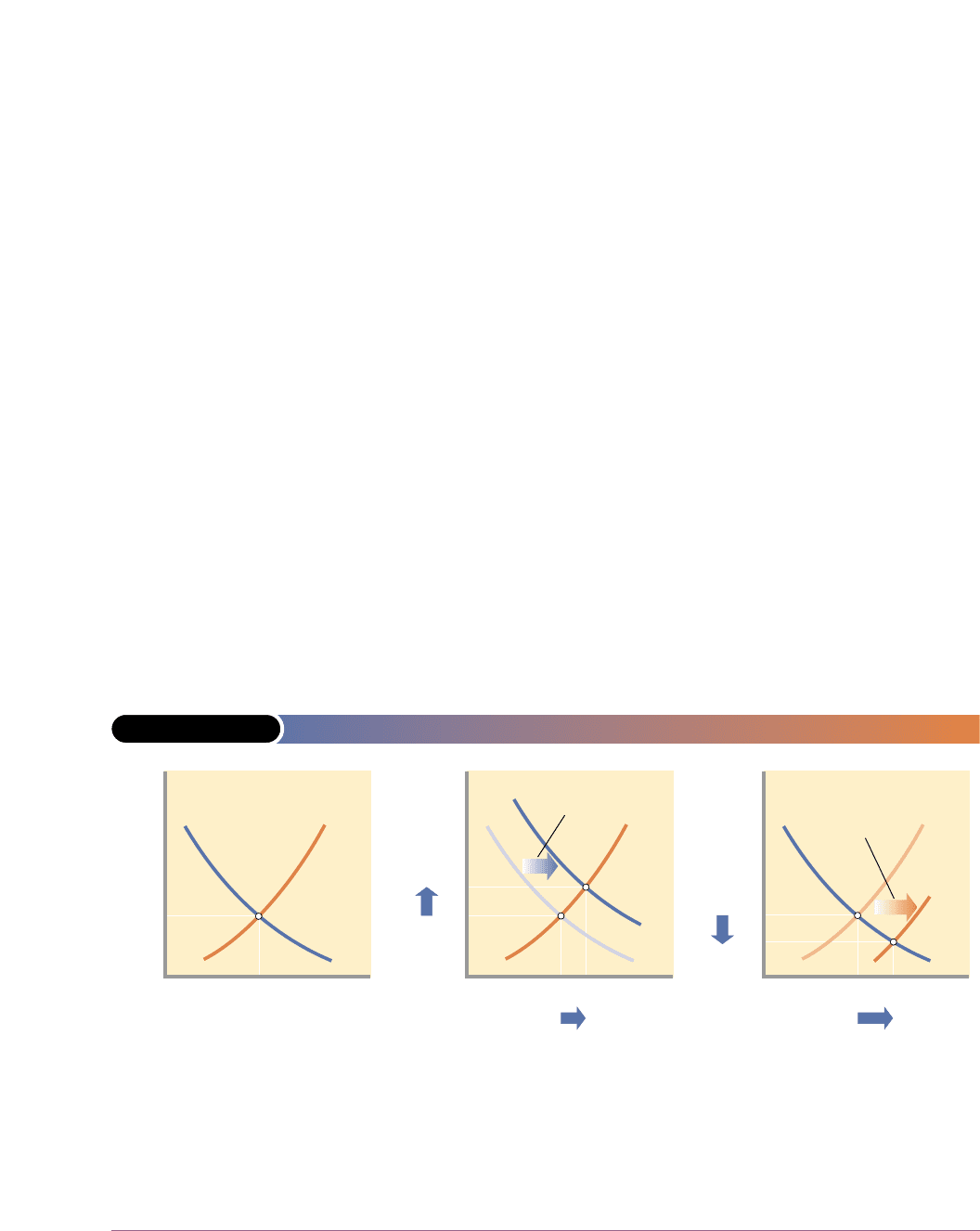McConnell Campbell R., Brue Stanley L., Barbiero Thomas P. Microeconomics. Ninth Edition
Подождите немного. Документ загружается.


Spillover Costs
Figure 18-2(a) illustrates how spillover costs affect the allocation of resources. When
producers shift some of their costs onto the community as spillover costs, produc-
ers’ marginal costs are lower than otherwise. So their supply curves do not include
or capture all the costs legitimately associated with the production of their goods.
A polluting producer’s supply curve such as S in Figure 18-2(a), therefore, under-
states the total cost of production. The firm’s supply curve lies to the right of (or
below) the full-cost supply curve S
t
that would include the spillover cost. Through
polluting and thus transferring cost to others in society, the firm enjoys lower pro-
duction costs and has the supply curve S.
The outcome is shown in Figure 18-2(a), where equilibrium output Q
e
is larger
than the optimal output Q
o
. This means that resources are overallocated to the pro-
duction of this commodity; too many units of it are produced.
Spillover Benefits
Figure 18-2(b) shows the impact of spillover benefits on resource allocation. When
spillover benefits occur, the market demand curve D lies to the left of (or below) the
full-benefits demand curve. That is, D does not include the spillover benefits of the
product, whereas D
t
does. Consider inoculations against a communicable disease.
Watson and Weinberg benefit when they get vaccinated but so do their associates
Alvarez and Anderson who are less likely to contract the disease from them. The
market demand curve reflects only the direct, private benefits to Watson and Wein-
berg; it does not reflect the spillover benefits—the positive externalities—to Alvarez
and Anderson, which are included in D
t
.
The outcome is that the equilibrium output Q
e
is less than the optimal output Q
o
.
The market fails to produce enough vaccinations and resources are underallocated
to this product.
Economists have explored several approaches to the problems of spillover costs
and benefits. Let’s first look at situations where government intervention is not
needed and then at some possible government solutions.
Individual Bargaining: Coase Theorem
In the Coase theorem, conceived by economist Ronald Coase at the University of
Chicago, government is not needed to remedy spillover costs or benefits where
462 Part Four • Microeconomics of Government and Public Policy
<www.best.com/
~ddfr/Academic/
Coase_World.html>
Coase and the
Nobel Prize
FIGURE 18-2 SPILLOVER COSTS AND SPILLOVER BENEFITS
P
Q
0
Spillover
costs
Q
o
Q
e
(a) Spillover costs
Overallocation
P
Q
0
Spillover
benefits
Q
o
Q
e
(b) Spillover benefits
D
S
S
t
D
S
t
D
t
Underallocation
Panel (a): With spillover costs
borne by society, the producers’
supply curve S is to the right of
(below) the full-cost curve S
t
.
Consequently, the equilibrium
output Q
e
is greater than the opti-
mal output Q
o
. Panel (b): When
spillover benefits accrue to soci-
ety, the market demand curve D
is to the left of (below) the full-
benefit demand curve D
t
. As a
result, the equilibrium output Q
e
is less than the optimal output Q
o
.
coase
theorem
The
idea first stated by
economist Ronald
Coase that spillover
problems may be
resolved through
private negotiations
of the affected
parties.
The
Effectiveness
of Markets

(1) property ownership is clearly defined, (2) the number of people involved is
small, and (3) bargaining costs are negligible. Under these circumstances the gov-
ernment should confine its role to encouraging bargaining between affected indi-
viduals or groups. Property rights place a price tag on an externality, creating
opportunity costs for all parties. Because the economic self-interests of the parties
are at stake, bargaining will enable them to find a mutually acceptable solution to
the externality problem.
EXAMPLE OF THE COASE THEOREM
Suppose the owner of a large parcel of forestland is considering a plan to clear-cut
(totally level) hundreds of hectares of mature fir trees. The complication is that the
forest surrounds a lake with a popular resort on its shore. The resort is on land it
owns. The unspoiled beauty of the general area attracts vacationers from all over the
nation to the resort, and the resort owner is against the clear-cutting. Should provin-
cial or municipal government intervene to allow or prevent the tree cutting?
According to the Coase theorem, the forest owner and the resort owner can
resolve this situation without government intervention. As long as one of the parties
to the dispute has property rights to what is at issue, an incentive will exist for both
parties to negotiate a solution acceptable to each. In our example, the owner of the
timberland holds the property rights to the land to be logged and thus has the right
to clear-cut it. The owner of the resort, therefore, has an economic incentive to nego-
tiate with the forest owner to reduce the logging impact. Excessive logging of the for-
est surrounding the resort will reduce tourism and revenues to the resort owner.
What is the economic incentive to the forest owner to negotiate with the resort
owner? The answer draws directly on the idea of opportunity cost. One cost
incurred in logging the forest is the forgone payment that the forest owner could
obtain from the resort owner for agreeing not to clear-cut the fir trees. The resort
owner might be willing to make a lump-sum or annual payment to the owner of the
forest to avoid or minimize the spillover cost. Or perhaps the resort owner might be
willing to buy the forested land to prevent the logging. As viewed by the forest
owner, a payment for not clear-cutting or a purchase price above the market value
of the land is an opportunity cost of logging the land.
It is likely that both parties would regard a negotiated agreement as better than
clear-cutting the firs.
LIMITATIONS
Unfortunately, many externalities involve large numbers of affected parties, high
bargaining costs, and community property such as air and water. In such situations
private bargaining cannot be used as a remedy. As an example, the global warming
problem affects millions of people in many nations. The vast number of affected par-
ties could not individually negotiate an agreement to remedy this problem. Instead,
they must rely on their governments to represent the millions of affected parties and
find an acceptable solution.
Nevertheless, the Coase theorem reminds us that in many situations, bargaining
between private parties can be useful in remedying spillover costs and spillover
benefits.
Liability Rules and Lawsuits
Although private negotiation may not be a realistic solution to many externality
problems, clearly established property rights may help in another way. The govern-
ment has erected a framework of laws that define private property and protect it
chapter eighteen • government and market failure 463
<environment.about.com/
newsissues/
environment/library/
weekly/aa050700.htm>
Environmental
externalities

from damage done by other parties. Those laws, and the damage recovery system to
which they give rise, permit parties suffering spillover costs to sue for compensation.
Suppose the Ajax Degreaser Company regularly dumps leaky barrels containing
solvents into a nearby canyon owned by Bar Q Ranch. Bar Q eventually discovers
this dumpsite and, after tracing the drums to Ajax, immediately contacts its lawyer.
Soon after, Bar Q sues Ajax. Not only will Ajax have to pay for the cleanup; it may
also have to pay Bar Q additional damages for ruining its property.
Clearly defined property rights and government liability laws thus help remedy
some externality problems. They do so directly by forcing the perpetrator of the harm-
ful externality to pay damages to those injured. They do so indirectly by discourag-
ing firms and individuals from generating spillover costs for fear of being sued. It is
not surprising, then, that many spillovers do not involve private property but rather
property held in common by society. It is the public bodies of water, the public lands,
and the public air, where ownership is less clear, that often bear the brunt of spillovers.
A caveat is in order here: like private negotiations, private lawsuits to resolve
externalities have their own limitations. Large legal fees and major time delays in the
court system are commonplace. Also, the uncertainty associated with the court out-
come reduces the effectiveness of this approach. Will the court accept your claim that
your emphysema has resulted from the smoke emitted by the factory next door, or
will it conclude that your ailment is unrelated to the plant’s pollution? Can you prove
that a specific firm in the area is the source of the contamination of your well? What
happens to Bar Q’s suit if Ajax Degreaser goes out of business during the litigation?
Government Intervention
Government intervention may be needed to achieve economic efficiency when
externalities affect large numbers of people or when community interests are at
stake. Government can use direct controls and taxes to counter spillover costs; gov-
ernment may provide subsidies or public goods to deal with spillover benefits.
DIRECT CONTROLS
The direct way to reduce spillover costs from a certain activity is to pass legislation
limiting that activity. Such direct controls force the offending firms to incur the
actual costs of the offending activity. To date, this approach has dominated public
policy in Canada. Historically, direct controls in the form of uniform emissions stan-
dards—limits on allowable pollution—have dominated American air pollution pol-
icy. Clean air legislation forces factories, cars, and businesses to install “maximum
achievable control technology” to reduce emissions. Clean-water legislation limits
the amount of heavy metals, detergents, and other pollutants firms can discharge
into rivers and bays. Toxic-waste laws dictate special procedures and dump sites for
disposing of contaminated soil and solvents. Violating these laws means fines and,
in some cases, imprisonment.
Direct controls raise the marginal cost of production because the firms must oper-
ate and maintain pollution-control equipment. The supply curve S in Figure
18-3(b), which does not reflect the spillover costs, shifts leftward (upward) to the
full-cost supply curve, S
t
. Product price increases, equilibrium output falls from Q
e
to Q
o
, and the initial overallocation of resources shown in Figure 18-3(a) is corrected.
SPECIFIC TAXES
A second policy approach to spillover costs is for government to levy taxes or
charges specifically on the related good. For example, the government has placed a
464 Part Four • Microeconomics of Government and Public Policy

manufacturing excise tax on CFCs, which deplete the stratospheric ozone layer pro-
tecting the earth from excessive solar ultraviolet radiation. Facing such an excise tax,
manufacturers must decide whether to pay the tax or expend additional funds to
purchase or develop substitute products. In either case, the tax raises the marginal
cost of producing CFCs, shifting the private supply curve for this product leftward
(or upward).
In Figure 18-3(b), a tax equal to T per unit increases the firm’s marginal cost, shift-
ing the supply curve from S to S
t
. The equilibrium price rises and the equilibrium
output declines from Q
e
to the economically efficient level Q
o
. The tax thus elimi-
nates the initial overallocation of resources.
SUBSIDIES AND GOVERNMENT PROVISION
Where spillover benefits are large and diffuse, as in our earlier example of inocula-
tions, government has three options for correcting the underallocation of resources:
1. Subsidies to buyers Figure 18-4(a) again shows the supply–demand situation
for spillover benefits. Government could correct the underallocation of resources,
for example, to inoculations, by subsidizing consumers of the product. It could
give each new mother in Canada a discount coupon to be used to obtain a series
of inoculations for her child. The coupon would reduce the price to the mother
by, say, 50 percent. As shown in Figure 18-4(b), this program would shift the
demand curve for inoculations from too low D to the appropriate D
t
. The num-
ber of inoculations would rise from Q
e
to the economically optimal Q
o
, eliminat-
ing the underallocation of resources shown in Figure 18-4(a).
2. Subsidies to producers A subsidy to producers is a specific tax in reverse. Taxes
impose an extra cost on producers, while subsidies reduce producers’ costs. As
shown in Figure 18-4(c), a subsidy of U per inoculation to physicians and medical
clinics would reduce their marginal costs and shift their supply curve rightward
from S
t
to S
t
⬘. The output of inoculations would increase from Q
e
to the optimal
level Q
o
, correcting the underallocation of resources shown in Figure 18-4(a).
chapter eighteen • government and market failure 465
FIGURE 18-3 CORRECTING FOR SPILLOVER COSTS (NEGATIVE
EXTERNALITIES)
P
Q
0
Spillover
costs
Q
o
Q
e
(a) Spillover costs
Overallocation
P
Q
0
Q
o
Q
e
T
(b) Correcting the overallocation
of resources via direct controls
or via a tax
D
S
S
t
D
S
S
t
Panel (a): Spillover costs
result in an overalloca-
tion of resources. Panel
(b): Government can cor-
rect this overallocation
in two ways: (1) the use
of direct controls, which
would shift the supply
curve from S to S
t
and
reduce output from Q
e
to
Q
o
, or (2) the imposition
of a specific tax T, which
would also shift the sup-
ply curve from S to S
t
,
eliminating the overallo-
cation of resources.

3. Government provision Finally, where spillover benefits are extremely large, the
government may decide to provide the product as a public good. The Canadian
government largely eradicated the crippling disease polio by administering free
vaccines to all children. India ended smallpox by paying people in rural areas to
come to public clinics to have their children vaccinated. (Key Question 4)
A Market-Based Approach to Spillover Costs
One novel approach to spillover costs involves only limited government action. The
idea is to create a market for externality rights. But before describing that approach,
we first need to understand the idea called the tragedy of the commons.
THE TRAGEDY OF THE COMMONS
The air, rivers, lakes, oceans, and public lands, such as parks and streets, are all
objects for pollution because the rights to use those resources are held in common
by society. No private individual or institution has a monetary incentive to maintain
the purity or quality of such resources.
We maintain the property we own, we paint and repair our homes periodically, for
example, in part because we will recoup the value of these improvements at the time
of sale. But as long as rights to air, water, and certain land resources are commonly
held and are freely available, no incentive exists to maintain them or use them care-
fully. As a result, these natural resources are overused and degraded or polluted.
For example, a common pasture in which anyone can graze cattle will quickly be
overgrazed, because each rancher has an incentive to graze as many cattle as possi-
ble. Similarly, commonly owned resources such as rivers, lakes, oceans, and the air
get used beyond their capacity to absorb pollution. Manufacturers will choose the
466 Part Four • Microeconomics of Government and Public Policy
FIGURE 18-4 CORRECTING FOR SPILLOVER BENEFITS (POSITIVE
EXTERNALITIES)
(a) Spillover benefits
P
Q
0
Q
o
Q
e
(c) Correcting the
underallocation of
resources via a subsidy
to producers
P
Q
0
Subsidy
Q
o
Q
e
Subsidy
U
(b) Correcting the
underallocation of
resources via a subsidy
to consumers
D
S
t
D
S
t
D
t
S
′
t
P
Q
0
Spillover
benefits
Q
o
Q
e
D
S
t
D
t
Underallocation
Panel (a): Spillover benefits result in an underallocation of resources. Panel (b): This underallocation can be corrected by a
subsidy to consumers, which shifts market demand from D to D
t
and increases output from Q
e
to Q
o
. Panel (c): Alternatively,
the underallocation can be eliminated by providing producers with a subsidy of U, which shifts their supply curve from S
t
to
S⬘
t
, increasing output from Q
e
to Q
o
.
tragedy
of the
commons
Air,
water, and public
land rights are
held in common by
society and freely
available, so no
incentive exists to
maintain or use
them carefully; the
result is overuse,
degradation, and
pollution.
<www.ecoplan.org/
com_index.htm>
The commons
sustainability agenda

least-cost combination of inputs and bear only unavoidable costs. If they can dump
waste chemicals into rivers and lakes rather than pay for proper disposal, some
businesses will be inclined to do so. Firms will discharge smoke into the air if they
can, rather than purchase expensive abatement facilities. Even federal, provincial,
and municipal governments sometimes discharge inadequately treated waste into
rivers, lakes, or oceans to avoid the expense of constructing expensive treatment
facilities. Many individuals avoid the costs of proper refuse pickup and disposal by
burning their garbage or dumping it in the woods.
The problem is mainly one of incentives. There is no incentive to incur internal
costs associated with reducing or eliminating pollution when those costs can be
transferred externally to society. The fallacy of composition also comes into play.
Each person and firm reasons their individual contribution to pollution is so small
that it is of little or no overall consequence. But their actions, multiplied by hun-
dreds, thousands, or millions, overwhelm the absorptive capacity of the common
resources. Society ends up with a degradation or pollution problem.
A MARKET FOR EXTERNALITY RIGHTS
This outcome gives rise to a novel policy approach to spillover costs—one that is
market oriented. The idea is that the government can create a market for external-
ity rights. We confine our discussion to pollution, although this same approach
might be used with other externalities.
OPERATION OF THE MARKET
In this market approach, an appropriate pollution-control agency would determine
the amount of pollutants that firms can discharge into the water or air of a specific
region annually while maintaining the water or air quality at some acceptable level.
Suppose the agency ascertains that 500 tonnes of pollutants can be discharged into
Metropolitan Lake and “recycled” by nature each year. Then 500 pollution rights,
each entitling the owner to dump one tonne of pollutants into the lake in one year,
are made available for sale to producers each year. The supply of these pollution
rights is fixed and, therefore, perfectly inelastic, as shown in Figure 18-5.
chapter eighteen • government and market failure 467
market for
externality
rights
A market
in which firms can
buy rights to dis-
charge pollutants.
FIGURE 18-5 A MARKET FOR POLLUTION RIGHTS
P
Q
$200
$100
0 500 750 1000
Quantity of One-tonne pollution rights
Price per pollution right
S
= Supply of
pollution
rights
D
2002
D
2012
The supply of pollution rights, S,
is set by the government, which
determines that a specific body
of water can safely recycle 500
tonnes of waste. In 2002, the
demand for pollution rights is D
2002
and the one-tonne price is $100.
The quantity of pollution is 500
tonnes, not the 750 tonnes it would
have been without the pollution
rights. Over time, the demand for
pollution rights increases to D
2012
and the one-tonne price rises to
$200. But the amount of pollution
stays at 500 tonnes, rather than
rising to 1000 tonnes.
The
Effectiveness
of Markets

The demand for pollution rights, represented by D
2002
in the figure, takes the same
downsloping form as the demand for any other input. At higher prices there is less
pollution, as polluters either stop polluting or pollute less by acquiring pollution-
abatement equipment. An equilibrium market price for pollution rights, here $100,
will be determined at which the environment-preserving quantity of pollution
rights is rationed to polluters. Figure 18-5 shows that if the use of the lake as a
dumpsite for pollutants were free, 750 tonnes of pollutants would be discharged
into the lake; it would be overconsumed, or polluted, in the amount of 250 tonnes.
Over time, as human and business populations expand, demand will increase, as
from D
2002
to D
2012
. Without a market for pollution rights, pollution in 2012 would be
1000 tonnes, 500 tonnes beyond what can be assimilated by nature. With the market
for pollution rights, the price would rise from $100 to $200, and the amount of pol-
lutants would remain at 500 tonnes—the amount that the lake can recycle.
ADVANTAGES
This scheme has several advantages over direct controls, the most important of
which is that it reduces society’s costs by allowing pollution rights to be bought and
sold. Suppose it costs Acme Pulp Mill $20 a year to reduce a specific noxious dis-
charge by one tonne while it costs Zemo Chemicals $8000 a year to accomplish the
same one-tonne reduction. Also assume that Zemo wants to expand production, but
doing so will increase its pollution discharge by one tonne.
Without a market for pollution rights, Zemo would have to use $8000 of society’s
scarce resources to keep the one-tonne pollution discharge from occurring. But with
a market for pollution rights, Zemo has a better option: it buys one tonne of pollu-
tion rights for the $100 price shown in Figure 18-5. Acme is willing to sell Zemo one
tonne of pollution rights for $100 because that amount is more than Acme’s $20 cost
of reducing its pollution by one tonne. Zemo increases its discharge by one tonne;
Acme reduces its discharge by one tonne. Zemo benefits (by $8000 – $100), Acme
benefits (by $100 – $20), and society benefits (by $8000 – $20). Rather than using
$8000 of its scarce resources to hold the discharge at the specified level, society uses
only $20 of those resources.
Market-based plans have other advantages. Potential polluters have a monetary
incentive not to pollute because they must pay for the rights to discharge effluent.
Conservation groups can fight pollution by buying up and withholding pollution
rights, thereby reducing pollution below governmentally determined standards. As
the demand for pollution rights increases over time, the growing revenue from the
sale of a fixed quantity of pollution rights could be devoted to environmental
improvement. At the same time, the rising price of pollution rights should stimu-
late the search for improved pollution-control techniques.
Table 18-3 reviews the major methods for correcting externalities.
Society’s Optimal Amount of Externality Reduction
Negative externalities such as pollution reduce the utility of those affected, rather
than increase it. These spillovers are not economic goods but economic “bads.” If
something is bad, shouldn’t society eliminate it? Why should society allow firms or
municipalities to discharge any impure waste into public waterways or to emit any
pollution into the air?
Reducing a negative externality has a price. Society must decide how much of a
reduction it wants to buy. Eliminating pollution might not be desirable, even if it
were technologically feasible. Because of the law of diminishing returns, cleaning
468 Part Four • Microeconomics of Government and Public Policy
Choosing
a Little More
or Less

up the last 10 percent of pollutants from an industrial smokestack normally is far
more costly than cleaning up the prior 10 percent.
The marginal cost (MC) to the firm and hence to society—the opportunity cost of
the extra resources used—rises as pollution is reduced further. At some point MC
may rise so high that it exceeds society’s marginal benefit (MB) of further pollution
abatement (reduction). Additional actions to reduce pollution will therefore lower
society’s well-being; total cost will rise more than total benefit.
MC, MB, AND EQUILIBRIUM QUANTITY
Figure 18-6 shows both the rising marginal-cost curve, MC, for pollution reduction
and the downsloping marginal-benefit curve, MB, for this outcome. MB slopes
chapter eighteen • government and market failure 469
TABLE 18-3 METHODS FOR DEALING WITH EXTERNALITIES
Problem Resource allocation outcome Ways to correct externalities
Spillover costs Overallocation of resources 1. Individual bargaining
(negative externalities) 2. Liability rules and lawsuits
3. Tax on producers
4. Direct controls
5. Market for externality rights
Spillover benefits Underallocation of resources 1. Individual bargaining
(positive externalities) 2. Subsidy to consumers
3. Subsidy to producers
4. Government provision
FIGURE 18-6 SOCIETY’S OPTIMAL AMOUNT OF POLLUTION
ABATEMENT
Socially
optimal amount
of pollution
abatement
Q
1
0
Amount of pollution abatement
Society’s marginal benefit and marginal
cost of pollution abatement
MC
MB
The optimal amount
of externality reduc-
tion—in this case,
pollution abate-
ment—occurs at Q
1
,
where society’s mar-
ginal cost MC and
marginal benefit MB
of reducing the
spillover are equal.

downward because of the law of diminishing marginal utility: the more pollution
reduction society accomplishes, the lower the utility (and benefit) of the next unit
of pollution reduction.
The optimal reduction of an externality occurs when society’s marginal cost and
marginal benefit of reducing that externality are equal (MC = MB). In Figure 18-6 this
optimal amount of pollution abatement is Q
1
units. When MB exceeds MC, additional
abatement moves society toward economic efficiency; the added benefit of cleaner air
or water exceeds the benefit of any alternative use of the required resources. When MC
exceeds MB, additional abatement reduces economic efficiency; there would be greater
benefits from using resources in some other way than to further reduce pollution.
In reality, it is difficult to measure the marginal costs and benefits of pollution
control. Nevertheless, Figure 18-6 demonstrates that some pollution may be eco-
nomically efficient not because pollution is desirable but because beyond some level
of control, further abatement may reduce our net well-being.
SHIFTS IN LOCATIONS OF CURVES
The locations of the marginal-cost and marginal-benefit curves in Figure 18-6 are not
forever fixed. They can, and probably do, shift over time. For example, suppose that
the technology of pollution-control equipment were to improve noticeably. We
would expect the cost of pollution abatement to fall, society’s MC curve to shift
rightward, and the optimal level of abatement to rise. Or suppose that society were
to decide that it wanted cleaner air and water because of new information about the
adverse health effects of pollution. The MB curve in Figure 18-6 would shift right-
ward, and the optimal level of pollution control would increase beyond Q
1
. Test
your understanding of these statements by drawing the new MC and MB curves in
Figure 18-6. (Key Question 7)
Solid-Waste Disposal and Recycling
One externality problem that has received widespread attention in Canada is solid
waste disposal. The root cause of the problem can be envisioned through the law of
conservation of matter and energy. This law holds that matter can be transformed
to other matter or into energy but can never vanish. All inputs (fuels, raw materi-
als, water, and so forth) used in the economy’s production processes will ultimately
result in an equivalent amount of waste. For example, unless it is continuously recy-
cled, the cotton found in a T-shirt ultimately will be abandoned in a closet, buried
in a dump, or burned in an incinerator. Even if it is burned, it will not vanish;
instead, it will be transformed into heat, smoke, and ash.
470 Part Four • Microeconomics of Government and Public Policy
optimal
reduction
of an
externality
The point at which
society’s marginal
cost and marginal
benefit of reducing
that externality
are equal.
● Policies for coping with the overallocation of
resources caused by spillover costs are (1) pri-
vate bargaining, (2) liability rules and lawsuits,
(3) direct controls, (4) specific taxes, and (5) mar-
kets for externality rights.
● Policies for correcting the underallocation of
resources associated with spillover benefits are
(1) private bargaining, (2) subsidies to produc-
ers, (3) subsidies to consumers, and (4) govern-
ment provision.
● The optimal amount of negative-externality
reduction occurs where society’s marginal cost
and marginal benefit of reducing the externality
are equal.
law of con-
servation
of matter
and energy
Matter can be
transformed into
other matter or
into energy but can
never vanish.

The law of conservation of matter and energy is most apparent in solid-waste dis-
posal. The millions of tonnes of garbage that accumulate annually in Canadian land-
fills (trash dumps) are a growing externality problem. Landfills in southern Ontario
in particular are either completely full or rapidly filling up. Garbage from there and
elsewhere is now being transported hundreds of miles to dumps in other municipal
jurisdictions.
On the receiving end, people in rural areas near newly expanding dumps are
understandably upset about the increased truck traffic on their highways and the
growing mounds of smelly garbage in municipal dumps. Moreover, some landfills
are producing serious water-supply pollution.
The high opportunity cost of urban and suburban land and the negative exter-
nalities created by dumps make landfills increasingly expensive. An alternative pol-
icy is to incinerate garbage in plants that produce electricity. But people object to
having garbage incinerators, with their accompanying truck traffic and air pollution,
close to their homes. Is there a better solution to the growing problem of solid waste?
Although garbage dumps and incinerators remain the primary garbage disposal
methods, recycling has received increased attention.
MARKET FOR RECYCLABLE INPUTS
Figure 18-7(a), which shows the demand and supply curves for some recyclable
product, such as glass, suggests the incentives for recycling.
The demand for recyclable glass derives from manufacturers that use recycled
glass as a resource in producing new glass. This demand curve slopes downward,
telling us that manufacturers will increase their purchases of recyclable glass as
its price falls.
chapter eighteen • government and market failure 471
FIGURE 18-7 THE ECONOMICS OF RECYCLING
S
1
D
1
P
1
PPP
Q
1
QQQ
0
Amount of recycling
Amount of recycling
P
1
Q
1
0
Price
Q
2
Price
P
2
P
3
Price
P
1
Amount of recycling
Q
1
0
Q
3
Increase in
demand
Increase in
supply
(a) Equilibrium price
and quantity
(b) Incentives to buy
recyclable inputs
(c) Incentives to sell
recyclable inputs
S
1
D
1
D
2
S
1
S
2
D
1
Panel (a): The equilibrium price and amount of materials recycled are determined by supply S
1
and demand D
1
. Panel (b):
Policies that increase the incentives for producers to buy recyclable inputs shift the demand curve rightward, say, to D
2
, and
raise both the equilibrium price and the amount of recycling. Panel (c): Policies that encourage households to recycle shift
the supply curve rightward, say, to S
2
, and expand the equilibrium amount of recycling. These policies, however, also reduce
the equilibrium price of the recycled inputs.
